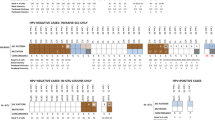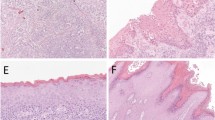Abstract
A number of reports associate human papillomavirus (HPV) with cervical cancer and cancer cell lines derived from this tumour type. Considerably fewer reports have focused on the role of HPV in carcinomas from other sites of female anogenital squamous epithelia. In this study we have tested for the presence of HPV in eight low-passage vulvar carcinoma cell lines and one extensively passaged cell line, A431. One cell line from a primary vaginal carcinoma was included. The presence of the HPV was evaluated by the polymerase chain reaction (PCR), by Southern blot analysis and by two-dimensional gel electrophoresis. General primer-mediated PCR was applied by using primers from the L1 region, E1 region and HPV 16 E7 region. Southern blot hybridisation was performed under low-stringency conditions (Tm = -35 degrees C) using a whole genomic HPV 6/16/18 probe mixture and under high stringency conditions (Tm = -18 degrees C) with the whole genomic probes of HPV 16 and 33. HPV 16 E6-E7 mRNA was assessed by ribonuclease protection assay (RPA). HPV was found in only one vulvar carcinoma cell line, UM-SCV-6. The identified type, HPV 16, was integrated in the cell genome and could be amplified with all primers used. Also E6-E7 transcripts were found in these cells. Five original tumour biopsies were available from the HPV-negative cell lines for in situ hybridisation. All these were HPV negative with both the HPV 6/16/18 screening probe mixture under low stringency and the HPV 16 probe under high stringency. The results indicate that vulvar carcinoma cell lines contain HPV less frequently than cervical carcinoma cell lines and suggest that a significant proportion of vulvar carcinomas may evolve by an HPV-independent mechanism.
This is a preview of subscription content, access via your institution
Access options
Subscribe to this journal
Receive 24 print issues and online access
$259.00 per year
only $10.79 per issue
Buy this article
- Purchase on Springer Link
- Instant access to full article PDF
Prices may be subject to local taxes which are calculated during checkout
Similar content being viewed by others
Author information
Authors and Affiliations
Rights and permissions
About this article
Cite this article
Hietanen, S., Grénman, S., Syrjänen, K. et al. Human papillomavirus in vulvar and vaginal carcinoma cell lines. Br J Cancer 72, 134–139 (1995). https://doi.org/10.1038/bjc.1995.289
Issue Date:
DOI: https://doi.org/10.1038/bjc.1995.289
This article is cited by
-
The interferon-β/STAT1 axis drives the collective invasion of skin squamous cell carcinoma with sealed intercellular spaces
Oncogenesis (2022)
-
DMRforPairs: identifying Differentially Methylated Regions between unique samples using array based methylation profiles
BMC Bioinformatics (2014)
-
Human papillomavirus and bladder cancer
International Urogynecology Journal And Pelvic Floor Dysfunction (1997)



